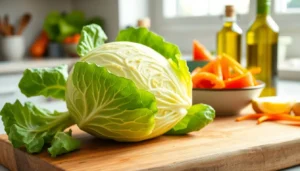Table of Contents
ToggleIn a world where salads often get a bad rap for being boring, meal prep salads are here to save the day—and your taste buds. Imagine diving into a colorful bowl of fresh greens, vibrant veggies, and delightful toppings, all ready to go when hunger strikes. It’s like having a delicious secret weapon in your fridge, ready to combat the dreaded afternoon slump or the “what’s for dinner?” dilemma.
Meal prep salads are not just a trend; they’re a game changer for busy lives. With a little planning, anyone can whip up satisfying, nutritious meals that make healthy eating a breeze. Plus, they make you feel like a culinary genius without the need for a Michelin star. So grab your mason jars and get ready to revolutionize your lunch game—because who said salads can’t be fun?
What Are Meal Prep Salads?
Meal prep salads consist of prepped ingredients combined to create nutritious meals for the week. These salads often feature a variety of components, including leafy greens, proteins, grains, and toppings. Meal prep salads provide a balanced mix of vitamins, minerals, and healthy fats, supporting overall well-being.
Preparation involves chopping vegetables, cooking proteins, and assembling the salads in advance. When made ahead, meal prep salads save time, allowing for easy grab-and-go options during busy workdays. Many individuals find that storing these salads in clear containers enhances visual appeal, making healthy choices more enticing.
Common ingredients in meal prep salads include quinoa, chickpeas, grilled chicken, spinach, and bell peppers. An array of dressings, such as balsamic vinaigrette or tahini sauce, adds flavor and keeps the salads fresh. They maintain quality for several days in the refrigerator, offering flexibility for meal planning.
Several techniques improve taste and texture, such as layering dense ingredients at the bottom and placing greens on top. This method prevents sogginess and maintains freshness throughout the week. Incorporating seasonal produce enhances taste and nutritional value, ensuring that the salads remain exciting.
Options exist for dietary preferences, including vegetarian, vegan, and gluten-free variations. Creative combinations can feature ingredients like roasted sweet potatoes, avocado, and sunflower seeds, providing diverse flavors. Meal prep salads not only promote healthier eating habits but also simplify weeknight dinners, making them a practical choice for anyone aiming to eat well.
Benefits of Meal Prep Salads
Meal prep salads offer numerous advantages, enhancing both nutrition and convenience for busy individuals. Their structured approach simplifies the process of maintaining healthy eating habits.
Health Benefits
Meal prep salads deliver essential nutrients, promoting overall health. Fresh ingredients like spinach and bell peppers provide vitamins A and C, boosting immunity. Proteins such as grilled chicken and chickpeas contribute to muscle maintenance and satiety. Incorporating whole grains like quinoa offers fiber, aiding digestion. The combination of diverse components creates a well-rounded meal for any dietary preference. Seasonal produce not only elevates taste but also increases nutritional value. With minimal effort, individuals enjoy meals that support their well-being.
Time-Saving Advantages
Meal prep salads save significant time during busy weeks. By preparing ingredients in advance, individuals eliminate daily shopping and cooking struggles. Storing salads in clear containers makes them easily accessible, encouraging healthy choices. A few hours spent on meal prep can yield satisfying lunches and dinners for several days. Layering ingredients retains freshness, ensuring salads taste great throughout the week. This structured approach allows for quick grab-and-go options, making meal choices effortless. Embracing meal prep transforms busy lifestyles into manageable routines.
Essential Ingredients for Meal Prep Salads
Selecting appropriate ingredients is crucial for preparing meal prep salads. A balanced approach enhances flavor and nutritional value.
Base Greens
Base greens act as the foundation for salads. Options include spinach, kale, romaine, and arugula. Spinach delivers iron and vitamins A and C. Kale offers antioxidants and fiber support. Romaine provides a crisp texture and fresh taste. Arugula adds peppery flavor and essential nutrients. Mixing different greens can create varied textures and tastes, making salads more enjoyable.
Proteins
Proteins contribute to meal satisfaction and muscle support. Choices like grilled chicken, chickpeas, and tofu are popular. Grilled chicken supplies lean protein while keeping meals hearty. Chickpeas offer plant-based protein and fiber among vegetarians and vegans. Tofu serves as a versatile option, absorbing flavors from dressings and seasonings. Including a variety of protein sources aids in achieving balanced nutrition throughout the week.
Toppings and Dressings
Toppings and dressings elevate salads with crunch and flavor. Nuts, seeds, and cheese add texture and healthy fats. Almonds, walnuts, and sunflower seeds provide essential fatty acids. Crumbled feta or goat cheese enhances taste and nutritional richness. Dressings such as balsamic vinaigrette, tahini sauce, or citrus-based options impart flavor, keeping salads exciting. Properly combining these elements maximizes both enjoyment and health benefits.
Tips for Successful Meal Prep Salads
Meal prep salads thrive on organization and proper techniques. Mastering storage and layering methods ensures freshness and flavor retention.
Proper Storage Techniques
Choosing the right container is essential for meal prep salads. Glass or BPA-free plastic containers offer durability and prevent flavor absorption. Use airtight lids to keep ingredients fresh and prevent spoilage. Storing salads in the refrigerator increases their longevity, with most ingredients maintaining quality for up to five days. Labeling containers with dates aids in keeping track of freshness. Fine-tuning portion sizes further simplifies grabbing a salad on busy days. Consider using dividers within containers to separate dressings or delicate ingredients, preserving their texture. Attention to storage details enhances the overall experience of enjoying nutritious salads throughout the week.
Layering for Freshness
Layering ingredients properly plays a crucial role in maintaining salad quality. Start with a base of denser ingredients like grains or proteins at the bottom of the container. These items create a barrier that protects lighter components like greens from moisture. Next, add vegetables that can withstand some weight, such as cucumbers and bell peppers. Place tender greens on top; these should resist wilting for as long as possible. Adding a small container for dressings prevents sogginess and keeps flavors bright. People can also mix ingredients just before eating for the best texture. By following these layering techniques, meal prep salads remain appealing and delicious all week long.
Meal prep salads offer a practical solution for those seeking to maintain healthy eating habits without sacrificing time or flavor. By incorporating a variety of ingredients and utilizing effective storage techniques, individuals can enjoy fresh and nutritious meals throughout the week. This approach not only simplifies meal planning but also encourages creativity in the kitchen. With meal prep salads, healthy eating becomes an enjoyable and sustainable part of everyday life. Embracing this method can lead to a more balanced diet and a more organized lifestyle, making it easier to thrive in today’s fast-paced world.




